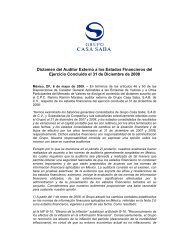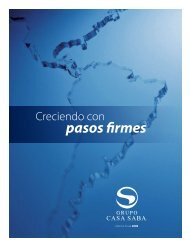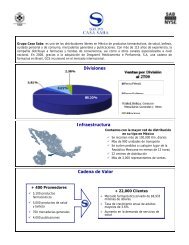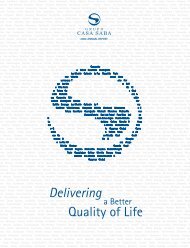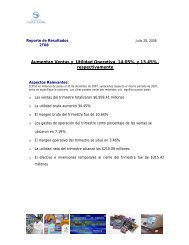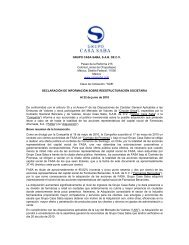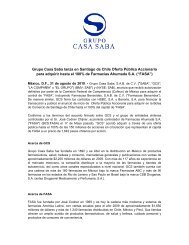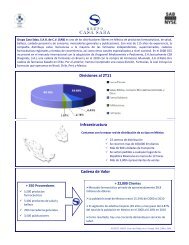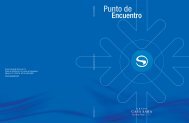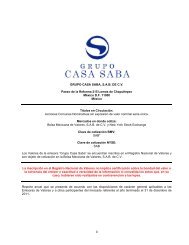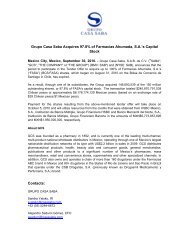FORM 20-F Grupo Casa Saba, S.A.B. de C.V.
FORM 20-F Grupo Casa Saba, S.A.B. de C.V.
FORM 20-F Grupo Casa Saba, S.A.B. de C.V.
Create successful ePaper yourself
Turn your PDF publications into a flip-book with our unique Google optimized e-Paper software.
Table of Contents<br />
g) Quantitative and qualitative disclosures about market risk<br />
The Group is subject to market risks due to interest rate fluctuations that prevail in Mexico, Brazil and effective October <strong>20</strong>10, Chile. Those fluctuations impact the long-term <strong>de</strong>bt<br />
incurred from loans obtained from Chilean and Mexican banks, as well as marketable bonds incurred by the Group. In addition, the Group obtained various secured and unsecured<br />
loans in various amounts for the financing of its operations as well as to acquire the shares issued and outstanding representative of the capital stock of FASA.<br />
The Group has managed its interest rate risks consi<strong>de</strong>ring the available financing rates in the market. In addition, at the issue date of the financial statements, the Group had entered<br />
into cash flows hedges contracts (Dollar / Peso Forwards). The Company agreed upon these transactions in different months of the year to look for a future U.S. dollar purchase price<br />
on different dates, and to be able to meet its U.S. dollar <strong>de</strong>nominated commitments. Management estimates that the changes in cash flows of these instruments maintain high<br />
effectiveness in offsetting the changes in cash flows of the primary position, both at the beginning and throughout the relationship of the <strong>de</strong>signated hedge. The Company does not<br />
carry out <strong>de</strong>rivative instruments trading.<br />
h) Fair value measurements<br />
ASC 8<strong>20</strong>, “Fair Value Measurements and disclosure” (ASC 8<strong>20</strong>) re<strong>de</strong>fines the concept of fair value and establishes a framework for the measurement of fair value, and enhances<br />
disclosures about fair value measurements. This guidance does not eliminate practicability exceptions that exist in accounting pronouncements amen<strong>de</strong>d by this guidance when<br />
measuring fair value.<br />
Un<strong>de</strong>r Mexican FRS, in addition to certain investments in trading securities which are recor<strong>de</strong>d at their quoted market prices, the Group recognizes its <strong>de</strong>rivative financial instruments at<br />
their estimated fair value. Un<strong>de</strong>r U.S. GAAP, the fair value is an “Exit Value,” which is the price that would be received to sell an asset or pay a liability in an or<strong>de</strong>rly transaction between<br />
market participants at the measurement date. Un<strong>de</strong>r Mexican FRS, fair value is equivalent a settlement amount at the balance sheet date while the Exit Value un<strong>de</strong>r U.S. GAAP consi<strong>de</strong>rs<br />
the counterparty’s credit risk in the valuation.<br />
The concept of Exit Value works un<strong>de</strong>r the premise that there is a market and market participants for the specific asset or liability. When there is no market and/or market participants<br />
willing to make a market, ASC 8<strong>20</strong> establishes a fair value hierarchy that prioritizes the inputs to valuation techniques used to measure fair value. The three levels of the fair value<br />
hierarchy are as follows: (i) unadjusted quoted prices in active markets that are accessible at the measurement date for i<strong>de</strong>ntical, unrestricted assets or liabilities; (ii) inputs that are<br />
observable, either directly or indirectly, but do not qualify as level (i) inputs and (iii) prices or valuation techniques that require inputs that are both significant to the fair value<br />
measurement and unobservable.<br />
i) Effective date of ASC 8<strong>20</strong><br />
On January 1, <strong>20</strong>09, the Group adopted ASC Topic 8<strong>20</strong>, “Fair Value Measurements and Disclosures”, for fair value measurements of non-financial assets and non-financial liabilities that<br />
are recognized or disclosed at fair value in the financial statements on a non-recurring basis. Examples of items within the scope of ASC 8<strong>20</strong> are nonfinancial assets and nonfinancial<br />
liabilities initially measured at fair value in a business combination (but not measured at fair value in subsequent periods), and long-lived assets, such as property, plant and equipment<br />
and intangible assets measured at fair value for an impairment assessment un<strong>de</strong>r the accounting for the impairment or disposal of long lived assets.<br />
F-65



